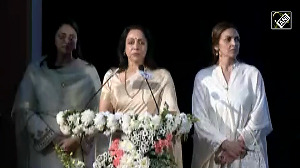Vijay Mallya, Chairman, UB group is addressing a press conference. Suddenly, a fire cracker bursts in the right hand corner of the room. As the smoke fades away, photographers begin frantically clicking snaps of model and actress Shilpa Shetty.
Wearing a silver coloured dress with red shoes -- vodka brand, Romanov's new colours -- she walks on to the stage in her role as the brand ambassador for Romanov.
Brand ambassadors are hardly newsworthy. But this is Romanov's third major change in the past two years. Mallya comments: "The relaunch was to keep the brand fresh and to cater to the young and upcoming population of India, who now have the propensity to spend."
In 2005, the UB Group consolidated all its alcohol businesses -- except beer -- under United Spirits. This meant that United Spirits now had to manage all the vodka brands of Shaw Wallace, McDowell and Triumph Distillers and Vintners.
In this new arrangement, United Spirits had a basket of half a dozen vodka brands -- Romanov, White Mischief and Alcazar at the mass end, and Vladivar and Alcazar AO2, as the premium brands.
But the license to use Vladivar expired and Alcazar AO2 did not excite consumers. These developments meant that although more than 70 per cent of the market is held by its three brands Romanov, White Mischief and Alcazar, all its eggs are in the same basket.
Meanwhile, at another level, Smirnoff had already established itself as the leader in the premium category (industry estimates). And this category has been growing rapidly.
As Euromonitor International, a market research firm's report in 2005 points out, there exists a niche segment of Indian consumers who are more than willing to pay for premium and super-premium offerings in vodka.
That explains the increasing offtake of vodka cases. From 140,000 cases in 2003, the premium segment is now close to 500,000 cases -- one-fourth of the two million cases Indian vodka market.
But where does that leave Romanov? As the vodka segment races ahead at a 40 per cent year-on-year growth rate, Romanov has been ambling along at 28.66 per cent (the brand's CAGR over the last four years). It's not just about not keeping up with market growth. There was also the danger of cannibalisation. Both Romanov and White Mischief carried the same price tag.
In late-2004, the company hired AC Nielsen, to conduct research on the needs and behaviour of vodka consumers. The key finding? Consumers thought the blend of Romanov wasn't smooth enough. The other feedback. Romanov's brand image which had not changed since 1996-97, was looked upon as fuddy-duddy.
New colours
This meant that the 29-year-old brand had to quickly re-adapt itself. Taking this into consideration, the company adopted a three-step strategy to rejuvenate Romanov.
First, the product went through a process change. Instead of double distillation, Romanov became triple distilled (purified three times to make it smoother) and played it up on its pack. But that's not new.
Since its launch in 1994, Smirnoff, the vodka brand from Diageo has always projected itself as a triple-distilled vodka.
The second step taken by the company was to revamp its brand image. Since its launch, Romanov was pitched as, "something more than the ordinary". The company has kept this alive. The brand's tagline now reads as Vonamor (sounds like wanna more and is Romanov spelt backwards).
In Feb 2004, the company started its Vonamor campaign and revamped Romanov's packaging. In June 2005, Romanov changed colours to silver and red from white and red. It also dethroned the czar which was prominent in earlier Romanov packs and his place was taken up by ice cubes. An effort was made to position Romanov as a premium drink.
Says Debashish Shyam, assistant vice president, UB Group, spirits division, "The packaging was not in line with its content, hence we decided to tweak it."
It was time to party. Enter, Shilpa Shetty, a continued effort to give the brand a premium positioning. But how will Romanov benefit from the association? Says Mallya, "We expect her to say that Romanov meets the aspirations of young, upcoming, responsible drinkers."
The company believes, that as Shetty is a stylish and aspirational icon, the brand shall also be seen in the same light. Hence, the company is going all-out promoting the association.
The company's annual advertising spends for Romanov is around Rs 5 crore (Rs 50 million). Now just one campaign will take up all that cash. The company plans a hoarding campaign in nearly 70 cities. A print campaign and glow sign boards at point of sales are also part of the plan.
Analysts say that Romanov will soon compete with Smirnoff head on. But how? At present, Smirnoff is priced at twice the price of Romanov. A 750 ml bottle of Smirnoff costs Rs 500, while Romanov costs Rs 252 -- prices are subject to a difference of Rs 10-15 due to local taxes.
That means Smirnoff is the young and aspiring customers' first premium choice. Romanov is often looked upon as the choice of the masses.
As the Euromonitor report says, "While the premium trend is predicted to continue, demand will remain strong for brands such as Romanov and White Mischief, which are aimed at the masses. Demand for mass brands is expected to be derived mainly from lower income consumers who desire a change from the usual Indian whiskey and brandy."
So is Romanov trying to vacate its mass-position and hand over that segment to White Mischief? Romanov does aspire to have a sexy appeal among the young party goer. But without hiking its price. Says Shyam, "At the moment we are focused on increasing our market share [which is estimated at 28-30 per cent among vodkas]."
But competitors feel that pricing is important. For instance, Smirnoff since its launch has made a conscious effort to be seen as a premium drink. But that was when Absolut and Belvedere the deluxe vodka brands had not set foot in India. Says Santosh Kanekar, director, marketing, Diageo India, "In the absence of direct advertising, price is the first indicator of a premium brand to its consumers."
But can a premium imagery alone work? It can happen, if done rightly, believes Vikram Achanta, co-founder and CEO, Tulleeho Portals. He says other brands have done it in the past. Royal Stag -- a whiskey brand -- has always been very premium in its brand imagery.
But its price is lower than premium whiskey brands. The old czar on Romanov's previous pack has made way for ice cubes. Will customers drink to that?






